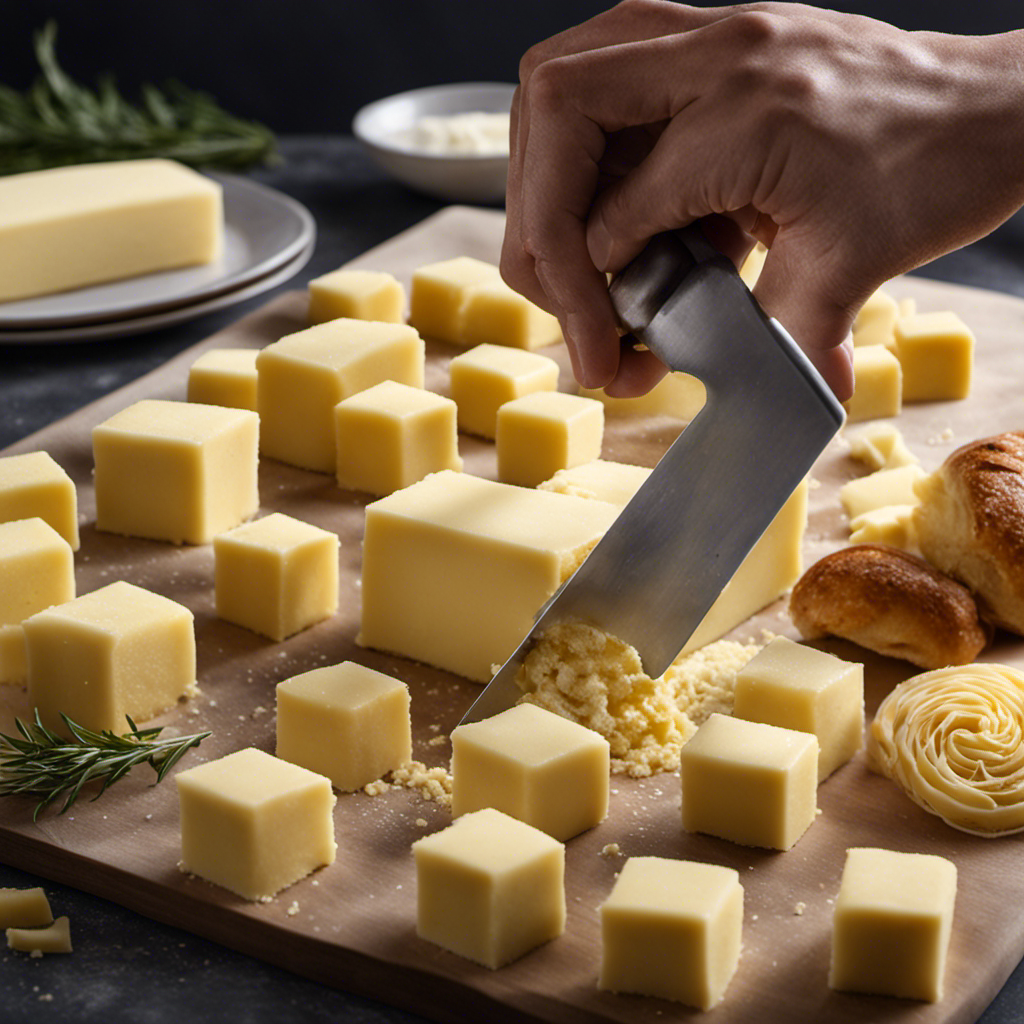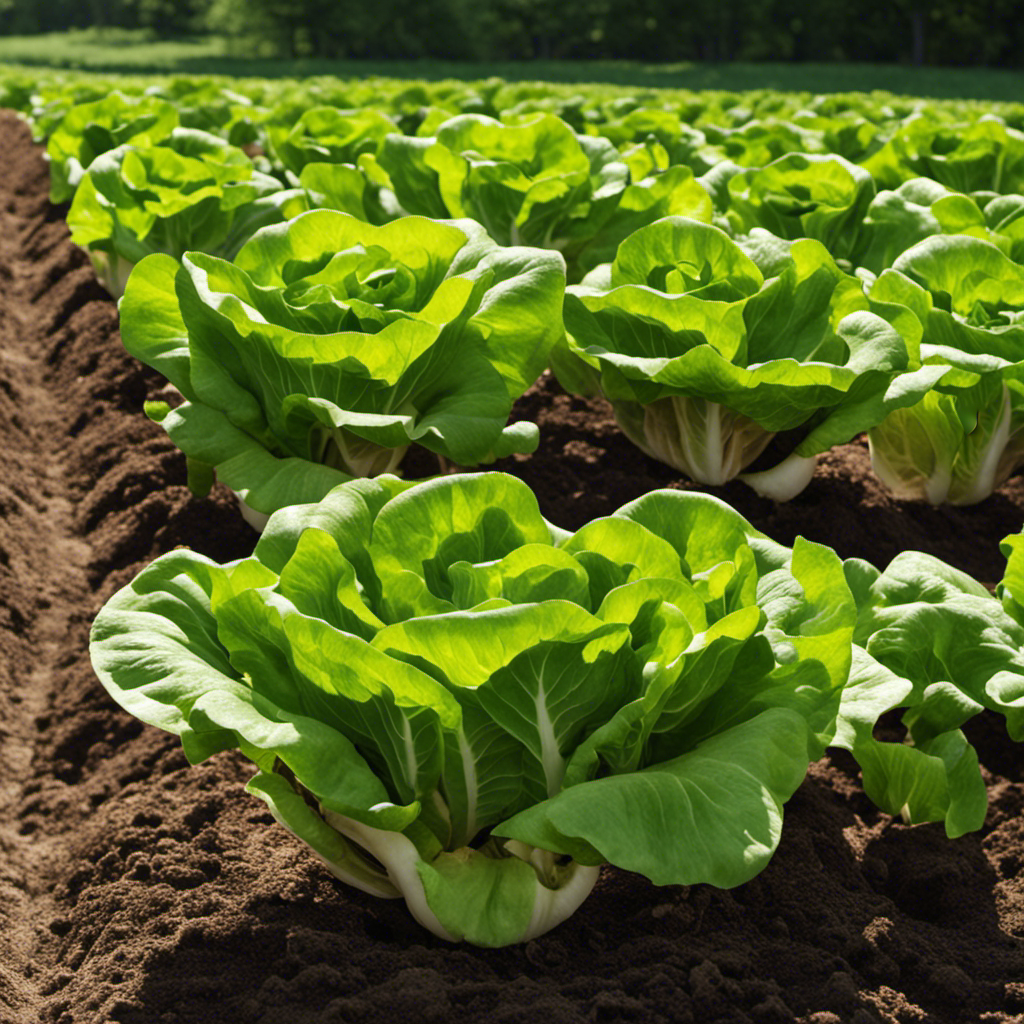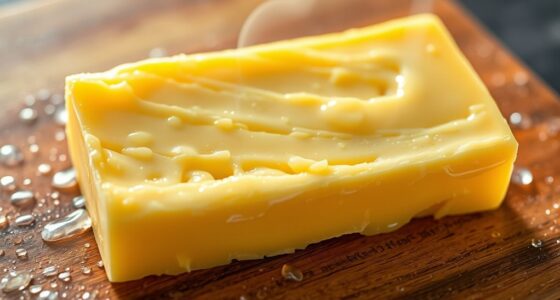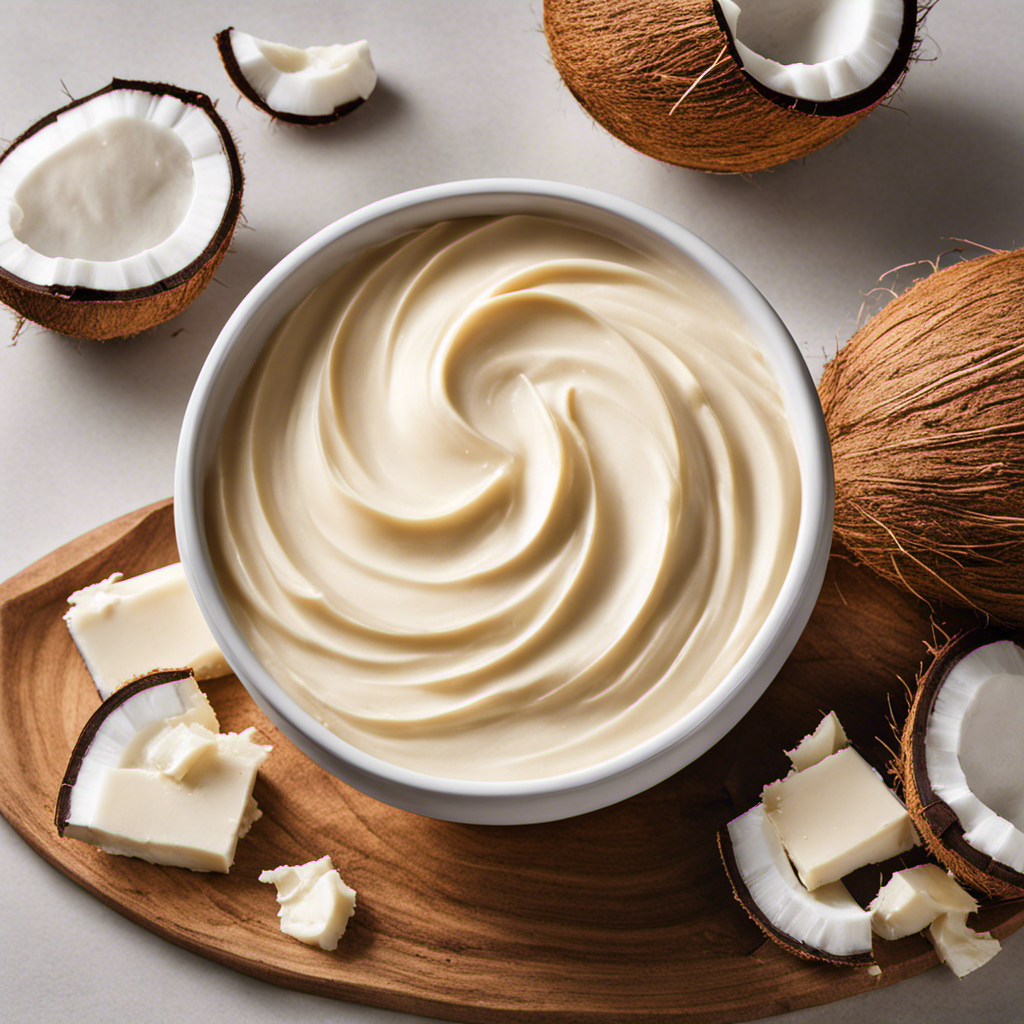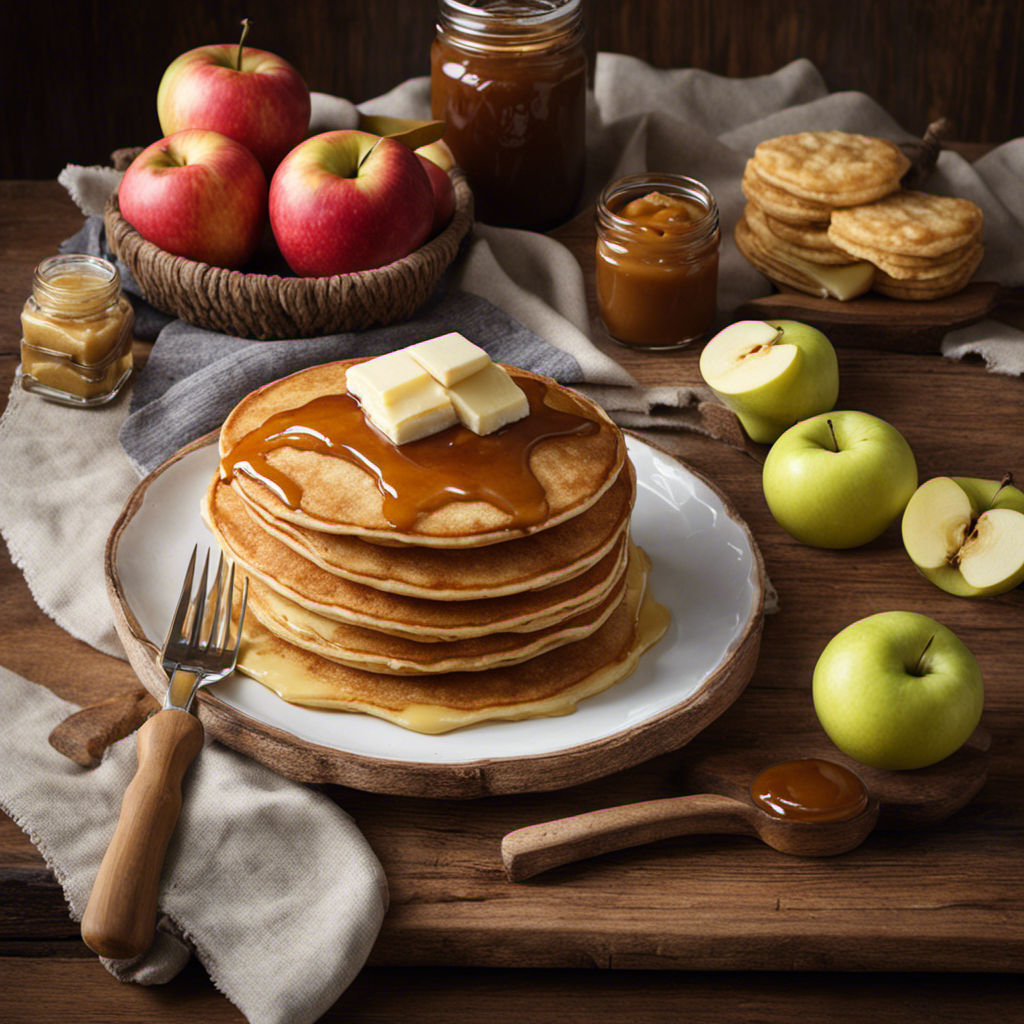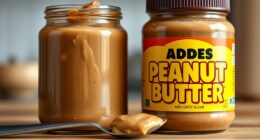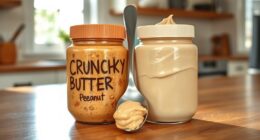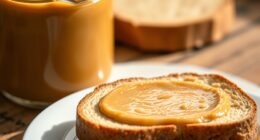As a home cook, I recognize the importance of mastering the art of cutting butter. It’s more than just slicing; it’s about obtaining the perfect consistency and seamlessly melding flavors.
In this article, I’ll guide you through the step-by-step process of softening butter, the science behind cold vs. room temperature butter cutting, and troubleshooting common issues.
From the classic cut-in method to advanced techniques and ideas, we’ll take your butter cutting skills to the next level.
Get ready to elevate your baking and cooking game with the art of cutting in butter.
Key Takeaways
- Proper butter cutting techniques are important for achieving desired results in baked goods.
- Choosing the right tools, such as knives or butter slicers, is crucial for cutting butter effectively.
- Sharp knives make spreading butter easier and more efficient, enhancing precision and control.
- Softening butter properly, by leaving it at room temperature or using other methods, is crucial for easier cutting and achieving the desired texture.
Understanding the Importance of Proper Butter Cutting Techniques
Understanding the importance of proper butter cutting techniques is crucial for achieving the desired results in your baked goods.
When it comes to cutting butter, using the right tools and methods can make a significant difference in the texture and consistency of your dough. There are various butter cutting tools available, such as pastry blenders, knives, or even your fingertips. Each tool has its advantages, but the key is to ensure that the butter is evenly distributed throughout the dough.
One popular method is the ‘rubbing in’ technique, where you use your fingertips to break up the butter into small pieces and then incorporate it into the flour mixture. Another method is using a pastry blender, which cuts the butter into small, uniform pieces.
Whichever method you choose, make sure to work quickly to prevent the butter from melting too much, as this can affect the final texture of your baked goods.
Choosing the Right Tools for Cutting Butter
When it comes to cutting butter, choosing the right knife is crucial. Different knife types are designed specifically for butter, such as a butter knife or a cheese knife with a serrated edge.
The sharpness of the knife is also important, as a dull blade can lead to squished or uneven slices. If you don’t have a suitable knife, there are also alternative butter slicers available that can make the task easier and more efficient.
Knife Types for Butter
To cut in butter, you’ll want to use a knife that’s specifically designed for this purpose. There are several knife options available, each with its own unique features that make cutting through butter a breeze. Here are three popular knife types for cutting butter:
| Knife Type | Description |
|---|---|
| Butter Knife | This knife has a rounded tip and a serrated edge, making it perfect for spreading butter on bread or toast. It allows for smooth, even spreading without tearing the bread. |
| Cheese Knife | Although designed for cutting cheese, a cheese knife can also be used to cut through cold butter. It typically has a wide, flat blade that makes it easy to slice through the butter without any effort. |
| Offset Spatula | While not technically a knife, an offset spatula can be a great tool for cutting in butter. Its long, narrow blade and angled handle provide excellent control and precision when cutting butter into flour for pastry dough. |
These knife options, combined with proper spreading techniques, will ensure that your butter is evenly distributed and your dishes turn out delicious every time.
Importance of Sharpness
The importance of having sharp knives is that they make the task of spreading butter much easier and more efficient. When it comes to cutting in butter, sharpness plays a vital role in achieving the desired results. Here are three reasons why sharp knives are important:
-
Smooth and Effortless Spreading: A sharp knife effortlessly glides through butter, allowing for smooth and even spreading on bread, toast, or any other surface.
-
Precision and Control: With a sharp knife, you have better control over the amount of butter you’re spreading, ensuring that you get the perfect amount every time.
-
Time-saving: Sharp knives reduce the effort required to cut in butter, making the process quicker and more efficient.
Butter Slicer Alternatives
If you’re looking for a different tool for slicing butter, you might want to consider trying out alternative options. While a traditional butter knife may be the go-to choice for most people, there are other tools available that can make the task easier and more efficient. To help you find the right alternative butter cutting tool, I have compiled a list of options along with their features and reviews in the table below:
| Tool Name | Features | Reviews |
|---|---|---|
| Butter Slicer | Adjustable thickness settings, ergonomic handle, stainless steel blade | "This butter slicer is a game changer! It slices through butter effortlessly." – User A |
| Cheese Plane | Thin and sharp blade, comfortable grip handle | "I use this cheese plane to slice butter and it works like a charm." – User B |
| Wire Butter Cutter | Wire design for precise slicing, easy to clean | "I love how precise this wire butter cutter is. It makes beautiful thin slices." – User C |
Step-by-Step Guide to Softening Butter for Cutting
When it comes to cutting butter, one important factor to consider is its temperature. Room temperature butter is easier to work with and yields better results than cold or melted butter.
To achieve the perfect texture, it is crucial to soften the butter properly before cutting. In this discussion, we will explore different techniques and step-by-step guides to ensure that you have the ideal room temperature butter for all your cutting needs.
Room Temperature Butter
To easily cut in butter, you’ll want it to be at room temperature. Room temperature butter is soft enough to be easily incorporated into dry ingredients, making it perfect for cutting into dough or creating a crumbly texture in pastries.
Here are some tips for softening butter and storing it at room temperature:
-
Leave it out: Simply place the butter on the counter and let it sit for about 30 minutes to an hour until it reaches room temperature. This method is quick and easy.
-
Microwave it: If you’re short on time, you can soften the butter in the microwave. Cut the butter into small pieces and microwave it in 10-second intervals, checking and stirring in between, until it’s soft but not melted.
-
Store it properly: If you often use room temperature butter, you can keep it on the counter in a covered butter dish or a butter keeper. This way, you’ll always have softened butter ready for cutting.
Cutting Techniques
Now that we have our room temperature butter ready, let’s move on to the next step: cutting techniques. Cutting in butter is an essential skill in many baking recipes, and mastering it can greatly improve the texture and consistency of your baked goods. Luckily, there are some butter cutting hacks that even beginners can use to achieve excellent results.
One popular technique is using a pastry cutter or a fork to cut the butter into small pieces. Simply press the tool into the butter and rock it back and forth until the butter breaks down into pea-sized crumbs.
Another method is grating the butter using a cheese grater on a large hole setting. This creates thin shreds of butter that can be easily incorporated into the dough.
Whichever method you choose, remember to work quickly to prevent the butter from melting too much. With a little practice, you’ll become a pro at butter cutting in no time!
The Science Behind Cold Vs. Room Temperature Butter Cutting
The science behind cutting in cold vs. room temperature butter is fascinating. When it comes to achieving cutting precision, the temperature of the butter plays a crucial role. Here’s why:
-
Cold butter: When butter is cold, it is firm and holds its shape better. This makes it easier to cut into small, uniform pieces, especially when making pastries or pie crusts. The cold temperature also helps to keep the butter from melting too quickly, which can affect the texture of the final product.
-
Room temperature butter: Room temperature butter is softer and more pliable. This makes it easier to incorporate into batters and doughs, resulting in a smoother and more evenly mixed mixture. However, it may be more challenging to achieve precise cutting when the butter is too soft, as it tends to stick to the knife or pastry cutter.
-
Finding the right temperature: The key to cutting butter with precision is finding the balance between cold and room temperature. For tasks that require small, defined pieces, such as making flaky biscuits, cold butter is ideal. On the other hand, when blending butter into a batter or dough, allowing it to come to room temperature is recommended for easier incorporation.
Understanding the role of butter temperature in cutting can help you achieve better results in your baking and cooking endeavors.
Mastering the Classic Cut-in Method for Butter
Mastering the classic cut-in method involves incorporating chilled butter into dry ingredients using a pastry cutter until the mixture resembles coarse crumbs. This technique is essential for creating flaky pastries, biscuits, and pie crusts.
However, if you don’t have a pastry cutter on hand or prefer alternative methods, there are a few options to consider.
One alternative is using two knives or a fork to cut the butter into the dry ingredients. Simply cross the knives or use the fork to cut through the butter, blending it with the dry mixture until it reaches the desired coarse texture.
Another option is grating frozen butter directly into the dry ingredients, using a box grater. This method allows for even distribution of butter throughout the mixture, resulting in a flaky and tender finished product.
While the classic cut-in method is commonly used in sweet recipes, it can also be applied to savory dishes, such as biscuits for a hearty breakfast or a savory pie crust for a delicious dinner.
Exploring Alternative Butter Cutting Techniques
If you don’t have a pastry cutter, there are alternative methods for incorporating chilled butter into dry ingredients. As someone who loves baking, I’ve had the opportunity to explore unique butter cutting tools and experiment with flavored butter cutting techniques. Here are three methods that I have found to be effective and enjoyable:
-
The Fork Method: Simply use a fork to mash the chilled butter into small pieces, pressing it against the sides of the bowl until it resembles coarse crumbs. This method works well for recipes that require a crumbly texture, like pie crusts or streusel toppings.
-
The Knife Method: Cut the chilled butter into small cubes and use a knife to chop it into the dry ingredients. This method allows for better control over the size of the butter pieces, resulting in a more even distribution throughout the mixture.
-
The Grater Method: If you prefer a more hands-on approach, try grating the chilled butter using a box grater. This creates fine, grated butter that can easily be incorporated into the dry ingredients, perfect for recipes like scones or biscuits.
Tips and Tricks for Achieving Perfectly Cut Butter
To achieve perfectly incorporated butter in your baked goods, you’ll want to ensure that the butter is cold and firm. This is essential for achieving a flaky texture and even distribution of the butter throughout your dough. Softening techniques can be used when you want the butter to blend more easily with other ingredients, but for cutting in butter, firmness is key.
Here are some tips and tricks for achieving perfectly cut butter:
-
Start with cold butter: Keep your butter in the refrigerator until you’re ready to use it. Cold butter will hold its shape better and make cutting in easier.
-
Use a pastry cutter or two knives: These tools are designed to cut the butter into small pieces and incorporate it into the dough. Simply press down on the butter and move the tool in a cutting motion until the butter is evenly distributed.
-
Work quickly: The goal is to cut the butter into pea-sized pieces. The longer you work with the butter, the more it will soften, so work as efficiently as possible.
Troubleshooting Common Butter Cutting Issues
When incorporating butter into your dough, it’s important to work quickly to prevent the butter from softening too much. Maintaining the right butter consistency is crucial for achieving flaky and tender baked goods. However, sometimes things don’t go as planned and you may encounter some common issues when cutting in butter.
Here are a few troubleshooting tips to help you overcome these problems:
-
Butter melting too quickly: If the butter starts melting before you’re finished cutting it into the dough, try chilling the dough for a few minutes to firm up the butter.
-
Uneven distribution: If you end up with unevenly distributed butter in your dough, try using a pastry cutter or your fingers to break up any large chunks and distribute them more evenly.
-
Overmixing: Be careful not to overmix the dough when cutting in butter, as this can result in a tough texture. Mix just until the butter is distributed in small, pea-sized pieces throughout the dough.
Enhancing Flavors With Infused Butter Cutting Techniques
When it comes to adding an extra burst of flavor to dishes, butter can be a game-changer.
In this discussion, we will explore the art of creating flavorful butter combinations by using a variety of ingredients such as herbs, spices, and even fruits.
We will also delve into the different methods of infusing butter with these ingredients to maximize their taste and aroma, ultimately enhancing the overall flavor profile of our culinary creations.
Flavorful Butter Combinations
One way to enhance the flavor of butter is by combining it with different herbs and spices. Flavored butter recipes can add a burst of deliciousness to any dish, and they are incredibly easy to make.
Here are three flavorful butter combinations that you can try:
-
Garlic and Herb Butter: Mix softened butter with minced garlic, chopped fresh herbs like parsley, rosemary, and thyme, and a pinch of salt. This aromatic butter is perfect for spreading on bread or melting over grilled meats and vegetables.
-
Lemon Pepper Butter: Zest a lemon and mix it with softened butter, freshly ground black pepper, and a squeeze of lemon juice. This tangy and peppery butter is excellent for adding a zing to seafood, roasted chicken, or steamed vegetables.
-
Chili Lime Butter: Combine softened butter with lime zest, freshly squeezed lime juice, minced chili peppers, and a sprinkle of salt. This spicy and citrusy butter is fantastic for adding a kick to corn on the cob, grilled shrimp, or even roasted potatoes.
Infusion Methods for Butter
To infuse butter with flavors, you can try using methods like melting the butter with herbs and spices or letting it sit with them at room temperature. Infused butter adds a delicious twist to your dishes and can be used in a variety of recipes. Whether you want to elevate your morning toast or enhance the flavors of your favorite pasta dish, infused butter is a versatile ingredient that can take your cooking to the next level.
Here are some popular infused butter recipes and their benefits:
| Infused Butter Recipe | Flavor Profile | Benefits |
|---|---|---|
| Garlic and Herb Butter | Savory and aromatic | Enhances the taste of roasted vegetables and grilled meats |
| Lemon and Dill Butter | Bright and refreshing | Perfect for seafood dishes and adds a zesty kick to salads |
| Cinnamon and Honey Butter | Warm and sweet | Delicious on pancakes, waffles, and baked goods |
| Chili Lime Butter | Spicy and tangy | Adds a kick to grilled corn, chicken, or roasted vegetables |
| Truffle Butter | Earthy and rich | Elevates pasta dishes, mashed potatoes, and popcorn |
Experiment with these infused butter recipes to discover new flavors and enhance your culinary creations. Enjoy the benefits of infused butter in your cooking and elevate your dishes to a whole new level.
Enhancing Taste With Butter
Enhancing the taste of your dishes is easy with infused butter. The process of infusing butter with different flavors can add a delightful twist to your favorite recipes. Here are three ways to make the most of infused butter:
-
Herb-infused butter: Mix softened butter with finely chopped herbs like parsley, rosemary, or thyme. This adds a burst of freshness to roasted vegetables or grilled meats.
-
Citrus-infused butter: Zest a lemon or an orange and mix it into softened butter. This tangy butter can be spread on toast, used for baking, or melted over seafood for a zesty kick.
-
Spiced-infused butter: Combine softened butter with spices like garlic, paprika, or cayenne pepper. This versatile butter can be used to sauté vegetables, spread on corn on the cob, or melt over popcorn for a flavorful snack.
Using butter cutting tools and using softened butter in your infused butter recipes will allow for easier mixing and blending of flavors. So why not elevate your dishes with the deliciousness of infused butter?
Incorporating Butter Cutting Into Baking and Cooking Recipes
When incorporating butter cutting into your baking and cooking recipes, it’s important to use a pastry cutter for the best results. A pastry cutter is a versatile tool that helps you achieve the perfect texture and consistency in your recipes. It allows you to cut cold butter into flour, creating a crumbly and flaky texture that is essential for pastries and pie crusts.
To soften butter for cutting, there are a few techniques you can use. One method is to leave the butter at room temperature for about 30 minutes until it becomes soft but not melted. Another technique is to grate the cold butter using a cheese grater, which helps distribute it evenly throughout the dough.
Flavor variations can also be achieved by incorporating different types of butter, such as salted or unsalted, into your recipes. Salted butter adds a hint of saltiness to your baked goods, while unsalted butter allows the other flavors in your recipe to shine through. Experimenting with different butter options can elevate the taste of your dishes and give them a unique twist.
To illustrate the different softening techniques and flavor variations, here is a table:
| Softening Techniques | Flavor Variations |
|---|---|
| Room temperature | Salted |
| Grating | Unsalted |
| Microwave | Flavored |
| Clarified | |
| Cultured |
Taking Butter Cutting to the Next Level: Advanced Techniques and Ideas
Using advanced techniques and creative ideas, you can elevate your baking and cooking recipes to new heights by incorporating innovative butter cutting methods.
With the help of advanced butter tools and techniques, you can achieve the perfect consistency and texture in your baked goods.
Here are three ways to take your butter cutting to the next level:
-
Use a pastry blender: This tool is designed to cut cold butter into flour quickly and evenly. Its multiple blades make it easy to incorporate the butter without overmixing.
-
Try the rubbing-in method: This technique involves rubbing cold butter into dry ingredients using your fingertips. It creates a crumbly texture that is perfect for pie crusts and scones.
-
Freeze and grate: Freeze the butter and grate it directly into your recipe. This method ensures that the butter is evenly distributed and results in a flaky texture.
Frequently Asked Questions
Can I Use Margarine Instead of Butter When Cutting in Butter?
Yes, you can use margarine instead of butter when cutting in butter. The pros of using margarine include a lower saturated fat content, while the cons include a different flavor and texture.
Can I Use a Food Processor or Blender to Cut in Butter?
Using a food processor or blender to cut in butter saves time and effort. The best technique is to pulse the machine until the butter is evenly distributed and resembles coarse crumbs.
How Long Does It Take for Butter to Soften at Room Temperature?
To speed up the process of softening butter at room temperature, you can try cutting it into smaller pieces or using a microwave on low power. Be cautious not to melt it completely.
Can I Use Melted Butter Instead of Softened Butter?
Using melted butter in baking recipes can be an alternative to softened butter. It blends easily and adds moisture to the final product. However, it may affect the texture and rise of certain baked goods.
Can I Use a Pastry Cutter Instead of a Fork When Cutting in Butter?
Using a pastry cutter instead of a fork when cutting in butter has its pros and cons. A pastry cutter can make the process quicker and easier, but a fork allows for better control and precision.
Conclusion
In conclusion, mastering the art of butter cutting is essential for achieving the perfect texture and flavor in your dishes. By understanding the science behind it and choosing the right tools, you can elevate your culinary skills.
Whether you’re baking, cooking, or experimenting with infused butter cutting techniques, there’s always room to take it to the next level. So, grab your knife, soften that butter, and let your creativity flow.
With practice and perseverance, you’ll soon become a butter cutting pro, adding a touch of richness to every bite.
